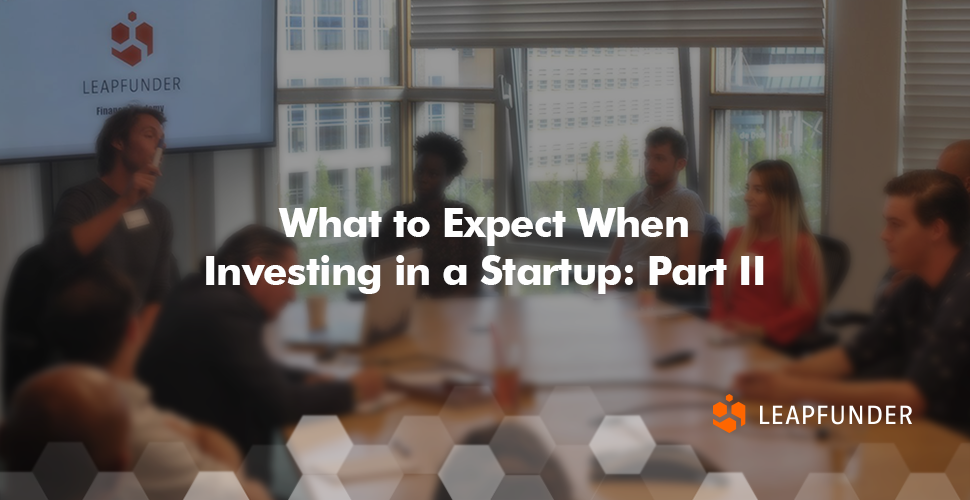Dear Investor,
This blog is part 2 of a step-by-step description of what will happen over time when you decide to invest in a startup with a convertible on Leapfunder. (Leapfunder is just a form of regular angel investing, so many of the points made here are generally applicable.)
In the first part, we explored what happens after you’ve decided to take the leap, focusing on the online angel investment process and looking at the Leapfunder convertible until the conversion. Now we will look at what comes next. We will also share some extra tips on how to avoid making basic angel investing mistakes.

Expectations when investing in a Startup with a Leapfunder Convertible: Part 2
Let us assume you have received shares and you can now proudly call yourself a shareholder. What exactly does this mean? With Leapfunder, the next phase is the Special Purpose Vehicle phase.
Special Purpose Vehicle (SPV) Phase
A special purpose vehicle is an entity which makes it possible to pool multiple investors into one. They are bundled together to make the process of holding shareholder meetings and gaining consensus easier. Let’s say a startup collects investment from 20 Angels. If an SPV were not used, the startup would have 20 investors on their cap table. In this case, a startup with 2 co-founders would have to invite all 20+2 investors to shareholders meetings, they would have to collect 20+2 signatures for official documents, and likely negotiate with 20 separate investors whenever something special needed to be agreed, etc… This will make the life of the startup and investors complex and it will consume much time.
If the startup has an SPV containing the 20 investors, there will be just 3 parties present at the shareholders meeting: the 2 co-founders and the SPV. This is why Leapfunder investment rounds almost always use an SPV. The Leapfunder SPV allows the SPV to be represented by one of the investors pooled inside it. This representative is generally one of the larger investors, chosen through a vote amongst the whole group. We have seen that typically most of the smaller investors are ‘passive’, meaning that not all 20 will want to be the elected representative. Since the representative has voting power the formal board positions within the SPV are predominantly just for administrative functions, and usually carried out by the startup itself.

Exit Phase
Though investing in a startup can be done in about 5 minutes nowadays – especially with a system like Leapfunder – startup investment is still a long-term game. Waiting for a cash return on investment – or ‘exit’ – is usually a process that can take between 5 and 7 years. It is more likely that a startup will contact the investor for new funding, perhaps several times, before announcing that they have sold the business and the investor has made 10X their initial investment.
What possible exits can you have when you have come into an SPV with your fellow investors?
- You can sell your SPV Shares to other investors. The market for startup investments is not as liquid as for shares of multinationals which are listed on the general stock exchanges. However, the market for startup investment is growing. Usually, the first interest is shown amongst the other investors in the same company, who may want to increase their position. Remember: there may be rules for offering shares which are startup-specific. Most startups have a first-refusal rule that requires you to offer any shares to other existing investors first.
- A larger company decides to buy the whole startup. In this case, the entire SPV will typically get an offer. Because of a possible drag-along in the shareholders’ agreement, you may be required to sell along with the other investors. Find out more on this in my shareholders’ agreement blog post.
- There could be an IPO. That means that the company becomes listed on an exchange. In Europe this is rare, but it obviously means it will become much easier to sell any shares that you may hold.
- The startup can become a normal cash-generating company! A startup can decide not to be acquired or have an IPO. Of course, these two options lead to a direct return for the investors. However, if the startup is profitable, it can use its own money to grow and can decide to pay out any remaining profit as a dividend to investors. This will not create an immediate high return, but it can lead to nice a stable yearly income for the investors. In the long-term, this can actually work out better for everyone.
Post-Exit Phase
Let us imagine we have been through all of the phases and, the startup has exited successfully, leaving you, the investor, an X amount richer than when you started. This may not the time to buy a house on an exotic tropical island. Perhaps it’s the time to start all over again! Startup investing is something you can learn from only through experience, not textbooks. I always advocate that investors need to diversify their portfolio between 5 and 10 startups – or as many as your mind can handle! Most startups will fail, but investors need to count on the 1 to 3 that will generate a return greater than 10X the initial investment. When you are starting, it is wise to invest smaller amounts until you gain valuable experience. As you gain experience, and have more success, you may want to increase the size of your portfolio. That means that profits could go back into more startups, also creating more value for everyone else involved. And of course … it’s fun.
Sign up to Leapfunder to discover promising new startups:



